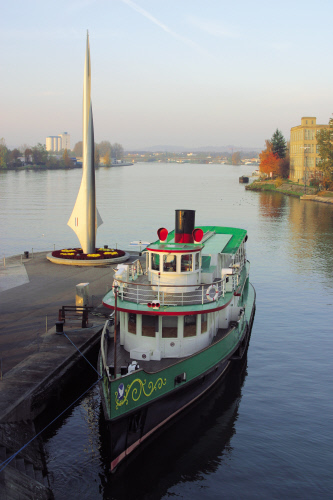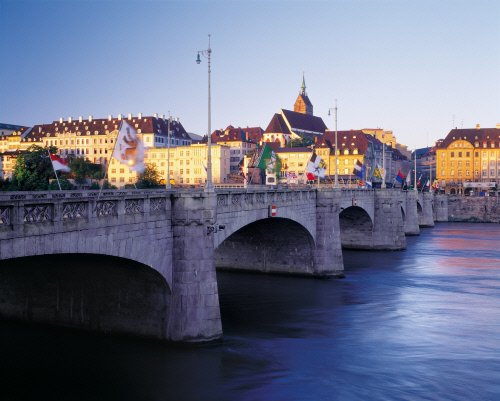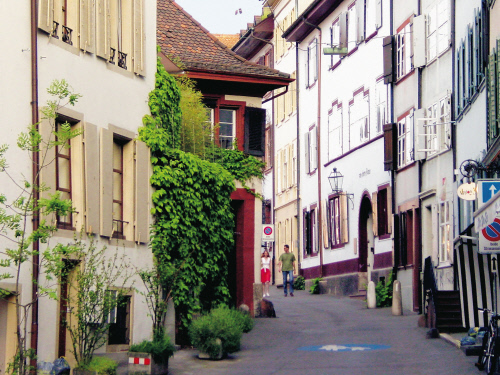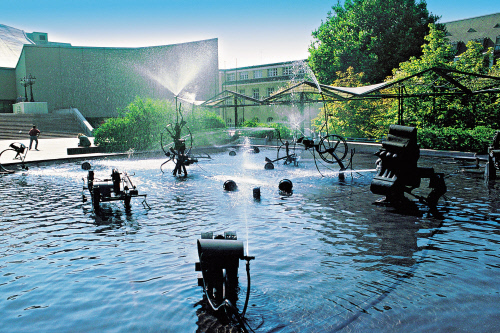WORLDWIDE TRAVEL NEWS ARTICLE

SWITZERLAND
THE CITY OF BASEL
One minute Tim Ware was driving through a rural scene of hillsides studded with vines, the next disappearing into a tunnel and, hey presto, he was in the centre of Switzerland’s city on the Rhine - Basel.
Cruising leisurely down the autoroute from Strasbourg, we arrive in Basel quicker than we expected. The subterranean expressway has the effect of speeding tourists – as well as commuters – into the city centre. Very efficient, very Swiss.

The River Rhine - Basel
Basel is an environmentally-conscious city so it comes as something of a surprise to discover that its wealth – it is generally considered Switzerland’s most affluent city - was built on the chemical industry. Today pharmaceuticals have taken over as the big money earner.
This most genteel of cities is close the point where Switzerland, France and Germany meet. It can trace its history back more than 2,000 years and became prosperous in the Middle Ages as an important centre on European trade routes. Its port on the river Rhine still provides land-locked Switzerland with its only outlet to the sea.

Three Country Corner in Basel
Considering its position, touching noses with three countries, you might think Basel would have a bit of an identity crisis. Not a bit of it. In fact, quite the opposite is true. In appearance and character, it is undeniably and implacably Swiss – and proud to be so.
It is also something of a centre of culture and learning. In the Middle Ages, it attracted scholars like the Rotterdam-born Desiderius Erasmus and, in the 19th century, the German philosopher Karl Jaspers. The painter Hans Holbein also felt at home and decided to put down his roots here.
Culture still plays an important part in the life of the city. Don’t go to Basel for nightlife – better fare is available in the nearby French and German towns and cities – but do go for fine museums, theatre, music and the chance to browse some excellent antiquarian bookshops.
As we wander through the old town our guide Rudolf, a man clearly sold on his adopted city, enthuses: “It’s a great place to live. The city is clean and green and because we’re part of one of the most prosperous parts of Europe, there is very little unemployment or poverty here.”
At Basel the Rhine makes a wide sweep as it meanders lazily downstream, separating Grosbasel on the left bank from Kleinbasel, on the right. The two communities have been united for more than 600 years. Grosbasel contains the old town and Kleinbasel the commercial part. The two are joined by the Mittlere Brǖcke – Middle Bridge – which, when it was built in 1226, was the lowest bridging point on the river.

Middle Bridge - Basel
Basel is small enough to get around easily on foot – we walked it comfortably in a couple of hours - yet large enough to hold plenty of interest for a two or three day visit. The centre of the old town - the original medieval heart - is full of steep, cobbled medieval streets and attractively quirky passageways which nowadays play host not so much to homes but the necessary paraphernalia of the tourist trade - coffee shops, restaurants and boutiques selling designer label clothes.

Old Town - Basel
Below the Műnster, the stallholders in the medieval Marktplatz – Market Square – are doing brisk business, providing a colourful backdrop to the rust coloured Rathaus – the City Hall. The seat of the Basel government has an attractive frescoed interior courtyard popular with pigeons who flit in and out of the late Burgundian-Gothic styled building.
Wandering through the old town we arrive at a local oddity - the Tinguely fountain – a reminder of Basel’s epic carnival, held over three days from the Monday after Mardi Gras. The fountain is actually a series of fountains – a group of sculptures, in the form of carnival exhibits. The fountain was created by the Swiss iron artist Jean Tinguely, a maverick postmodernist who extended the confines of sculpture to involve movement.

The Carnival Fountain by Tinguely
Tinguely used scrap metal, plastic and any other junk he could lay his hands on to create playful, almost Pythonesque machines to give a reminder that Basel, despite its business pretensions, can be a fun city. In winter when, as elsewhere in Switzerland, the temperature habitually drops below zero, the fountain has to be switched off.
Much of Basel’s art, it has to be said, is of a more serious nature. We spend a good hour in the Kunstmuseum, sometimes portrayed as the oldest art collection in the world.
At the entrance is Auguste Rodin’s Les Bourgeois de Calais and soon we’re immersing ourselves in the gallery’s hugely impressive collection of works both ancient and (relatively) modern. A Hans Holbein here, a Picasso there – soon we we became somewhat blasé about the richness of the art before us. Part of the collection came after the people of Basel took a democratic vote on whose additional works should go into the gallery. Picasso was a firm favourite and the great man was so touched that he donated several more of his own.

The Fondation Bayeler
From the city centre take the No 6 tram and, at Baselstrasse in the suburb of Riehen, you arrive at the Fondation Bayeler, a dazzling private collection containing works by Cėzanne, Matisse, Picasso and many others – a collection which rivals that found in the Kunstmuseum.
If you have time at the end of your city visit, you may well be tempted to hop across the border and see something of the French and Germany sides of the Rhine.
On the French side Strasbourg, seat of the European Parliament, and Colmar, which has a superb collection of timber-framed buildings, are well worth visiting as are, on the German side, the Black Forest and its ‘capital’ Freiburg. All are within a couple of hours’ drive of Basel.
Or, if you feel like celebrating, you could take yourself off on a two-day gastronomic cruise down the Rhine from Basel to Strasbourg (www.croisieurope.com). On each departure, three Michelin-starred chefs from restaurants in Switzerland, Germany and France are on board to prepare a five-course gastronomic dinner as you cruise downstream. Memories of the meal, like the scenery, are destined to stay with you long after you return home.
Visit: www.myswitzerland.com
You may also like to read

SWITZERLAND - A COUNTRY OVERVIEW
Tour-smart shows you that Switzerland is a country with a healthy regard for the outdoor life.

SWITZERLAND - TIME OUT IN THE WATCH VALLEY
Time flies, so it has been said, but in the Swiss region of the Jura, Tour-smart’s Anna Hyman found that it had slowed to a blissfully relaxed pace.

Comments